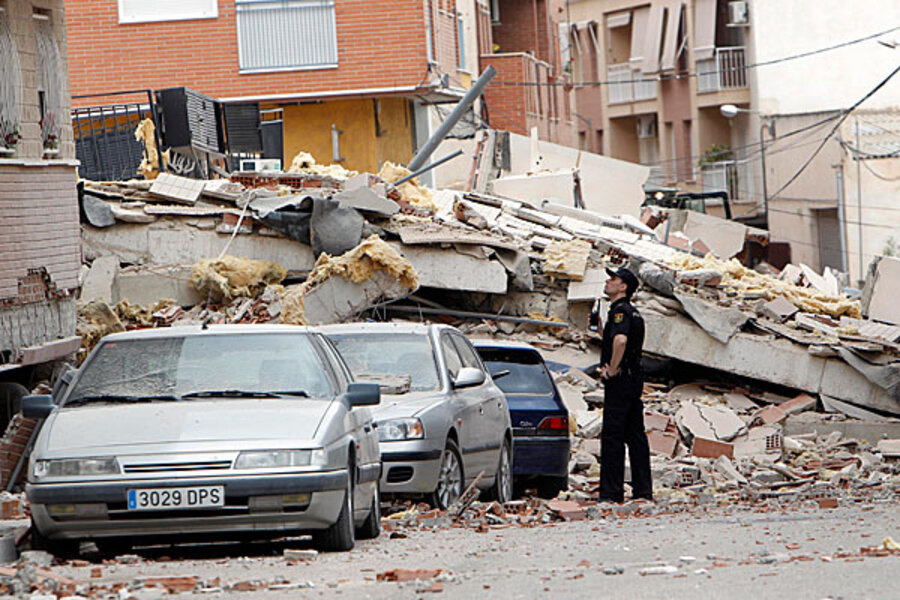Lorca 5.1 earthquake: Blame Spain's farmers and their deep wells?
Loading...
| Madrid
Farmers drilling ever deeper wells over decades to water their crops likely contributed to a deadly earthquake in southern Spain last year, a new study suggests. The findings may add to concerns about the effects of new energy extraction and waste disposal technologies.
Nine people died and nearly 300 were injured when an unusually shallow magnitude-5.1 quake hit the town of Lorca on May 11, 2011. It was the country's worst quake in more than 50 years, causing millions of euros in damage to a region with an already fragile economy.
Using satellite images, scientists from Canada, Italy and Spain found the quake ruptured a fault running near a basin that had been weakened by 50 years of groundwater extraction in the area.
RECOMMENDED: Are you scientifically literate? Take the quiz
During this period, the water table dropped by 250 meters (274 yards) as farmers bored ever deeper wells to help produce the fruit, vegetables and meat that are exported from Lorca to the rest of Europe. In other words, the industry that propped up the local economy in southern Spain may have undermined the very ground on which Lorca is built.
The researchers noted that even without the strain caused by water extraction, a quake would likely have occurred at some point.
But the extra stress of pumping vast amounts of water from a nearby aquifer may have been enough to trigger a quake at that particular time and place, said lead researcher Pablo J. Gonzalez of the University of Western Ontario, Canada.
Miguel de las Doblas Lavigne, a geologist with Spain's National Natural Science Museum who has worked on the same theory but was not involved in the study, said the Lorca quake was in the cards.
"This has been going on for years in the Mediterranean areas, all very famous for their agriculture and plastic greenhouses. They are just sucking all the water out of the aquifers, drying them out," he told The Associated Press in a telephone interview. "From Lorca to (the regional capital of) Murcia you can find a very depleted water level."
De las Doblas said it was "no coincidence that all the aftershocks were located on the exact position of maximum depletion."
"The reason is clearly related to the farming, it's like a sponge you drain the water from; the weight of the rocks makes the terrain subside and any small variation near a very active fault like the Alhama de Murcia may be the straw that breaks the camel*s back, which is what happened," he said.
He said excess water extraction was common in Spain.
"Everybody digs their own well, they don't care about anything," he said. "I think in Lorca you may find that some 80 percent of wells are illegal."
Lorca town hall environment chief Melchor Morales said the problem dates back to the 1960s when the region opted to step up its agriculture production and when underground water was considered private property. A 1986 law has reduced the amount of well pumping, he said.
Not everyone agreed with the conclusion of the study, which was published online Sunday in Nature Geoscience.
"There have been earthquakes of similar intensity and similar damage caused in the 17th, 18th and 19th centuries when there was no excess water extraction," said Jose Martinez Diez, a professor in geodynamics at Madrid's Complutense University who has also published a paper on the quake.
Still, it isn't the first time that earthquakes have been blamed on human activity, and scientists say the incident points to the need to investigate more closely how such quakes are triggered and how to prevent them.
The biggest man-made quakes are associated with the construction of large dams, which trap massive amounts of water that put heavy pressure on surrounding rock.
The 1967 Koynanagar earthquake in India, which killed more than 150 people, is one such case, said Marco Bohnhoff, a geologist at the German Research Centre for Geosciences in Potsdam who wasn't involved in the Lorca study.
Bohnhoff said smaller man-made quakes can also occur when liquid is pumped into the ground.
A pioneering geothermal power project in the Swiss city of Basel was abandoned in 2009 after it caused a series of earthquakes. Nobody was injured, but the tremors caused by injecting cold water into hot rocks to produce steam resulted in millions of Swiss francs (dollars) damage to buildings.
Earlier this year, a report by the National Research Council in the United States found the controversial practice of hydraulic fracturing to extract natural gas was not a huge source of man-made earthquakes. However, the related practice of shooting large amounts of wastewater from "fracking" or other drilling activities into deep underground storage wells has been linked with some small earthquakes.
In an editorial accompanying the Lorca study, geologist Jean-Philippe Avouac of the California Institute of Technology said it was unclear whether human activity merely induces quakes that would have happened anyway at a later date. He noted that the strength of the quake appeared to have been greater than the stress caused by removing the groundwater.
"The earthquake therefore cannot have been caused entirely by water extraction," wrote Avouac. "Instead, it must have built up over several centuries."
Still, pumping out the water may have affected how the stress was released, and similar processes such as fracking or injecting carbon dioxide into the ground — an idea that has been suggested to reduce the greenhouse effect — could theoretically do the same, he said.
Once the process is fully understood, "we might dream of one day being able to tame natural faults with geo-engineering," Avouac said.
RECOMMENDED: Are you scientifically literate? Take the quiz
___
Jordans reported from Istanbul. Ciaran Giles in Madrid and AP Science Writer Alicia Chang in Los Angeles contributed to this report.
Copyright 2012 The Associated Press.







